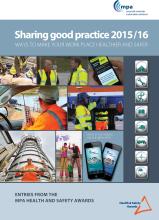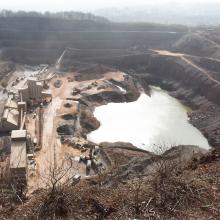The first step towards the development of a new cross-industry approach on the control of mineral dust in quarries and other workplaces has been taken this week, says the Institution of Occupational Safety and Health (IOSH).
Experts from across UK industry have agreed to work collaboratively with IOSH to develop a new way of sharing good practice around tackling respirable crystalline silica (RCS) exposure across industry.
It follows a roundtable discussion at The Shard, in London, on Monday 14 March which was held to coincide with the launch by IOSH of new guidance for businesses on the issue of RCS.
Representatives from the
Shelley Frost, executive director of policy at IOSH, said: “Dust is not just dust – it can contain elements that are potentially harmful and can cause chronic ill health.
“We brought together people from very different disciplines so we could really establish a collaborative and collective approach on raising awareness of RCS, and also address some of the current issues.
“What was really clear is there are many examples of good practice across industry and that should be celebrated. Our responsibility is to break down the barriers that exist in sharing this across all industry.”
According to Imperial College London research, around 800 people in Britain a year die from lung cancer caused by prolonged exposure to respirable crystalline silica (RCS) at work, with 900 new cases being diagnosed annually.
Kevin Stevens, health and safety manager at the Mineral Products Association, said much work to prevent RCS exposure has been done in the quarrying sector that other industries could learn from.
He said: “Silica dust is one of the oldest occupational health diseases we know of. The common challenge across industry is about educating individuals of the issue.
“Without question the information is out there but we need to make sure it is shared among all those who require it.”
Dr Claire Dickinson, occupational health programme manager at the ORR, said awareness of RCS in the rail sector was growing, particularly around the use of track ballast.
More work needed to be done to highlight the issue to those working on other construction projects in the rail sector, she added.
“We really need to up our game at getting through to the managers and supervisors on track and working at station construction sites,” she said.
IOSH has identified that a lack of understanding or awareness of silica dust as a hazard is a common cross-industry barrier to effective control of the issue.
Silica dust is one of five common agents associated with work-related cancer registrations and deaths in the UK that the institution is highlighting through its No Time to Lose occupational cancer campaign.
Asbestos, diesel engine exhaust fumes, solar radiation and shift work are also being highlighted as part of the campaign, which aims to get work-related cancer more widely understood and help businesses take action.
For more information about the campaign, and to download the free resources on RCS, visit %$Linker:









